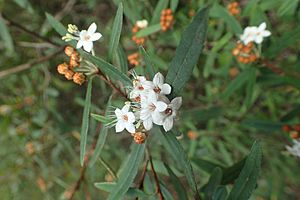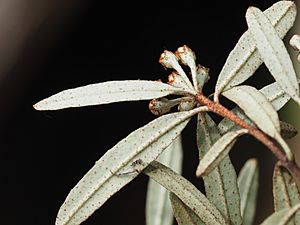Wallum phebalium facts for kids
Quick facts for kids Wallum phebalium |
|
|---|---|
 |
|
| In Sherwood Nature Reserve, near Glenreagh | |
| Scientific classification | |
| Genus: |
Phebalium
|
| Species: |
woombye
|
| Synonyms | |
|
|
The wallum phebalium (scientific name: Phebalium woombye) is a special type of shrub that grows only in eastern Australia. It's known for its unique look: its branches are covered with tiny scales and star-shaped hairs. This plant has oval-shaped leaves and pretty white to pink flowers. These flowers grow in clusters, usually with four to ten flowers in each group.
Contents
What Does Wallum Phebalium Look Like?
The wallum phebalium is a shrub that usually grows up to 2 meters (about 6.5 feet) tall. Its small branches are covered with tiny, flat scales and hairs that look like stars.
Leaves and Flowers
The leaves of this plant are shaped like long ovals. They are about 15 to 60 millimeters (0.6 to 2.4 inches) long and 2 to 11 millimeters (0.08 to 0.4 inches) wide. They sit on a short stem called a petiole. The top side of the leaves is flat and smooth, while the bottom side has a clear middle vein and is covered with shiny, silver-colored scales.
The flowers grow in clusters at the ends of the branches. Each cluster has four to ten flowers, and each flower sits on a small stalk called a pedicel, which is about 4 to 15 millimeters long. The base of the flower, called the calyx, is shaped like a top and is about 3 millimeters long. It has small teeth and is covered with silver to rust-colored scales both inside and out.
The petals of the wallum phebalium are white or pink. They are shaped like an egg, with the narrower part at the bottom. Each petal is about 6 millimeters long and 2.5 millimeters wide. The back of the petals is covered with rust-colored scales. This shrub usually blooms from July to August.
How Did Wallum Phebalium Get Its Name?
This plant was first officially described in 1898 by a scientist named Frederick Manson Bailey. He gave it the name Asterolasia woombye. He wrote about it in the Queensland Agricultural Journal after finding samples near a place called Woombye.
Later, in 1913, another scientist named Karel Domin changed its name to Phebalium woombye. He published this change in a science journal called Repertorium Specierum Novarum Regni Vegetabilis.
Where Does Wallum Phebalium Grow?
The wallum phebalium mostly grows in sandy areas along the coast. Sometimes, it can also be found a bit further inland. You can find this plant in south-east Queensland and as far south as Glenreagh in New South Wales.


